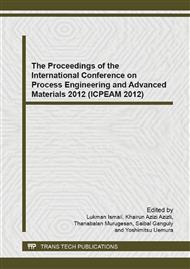[1]
H.J. Herzog, Peer Reviewed: What Future for Carbon Capture and Sequestration? Envi Sci Tech, 35 (2001) 148A-153A.
DOI: 10.1021/es012307j
Google Scholar
[2]
IEA, CO2 Capture and Storage: A key carbon abatement option, International Energy Agency, France, (2008).
DOI: 10.1787/9789264041417-en
Google Scholar
[3]
N.H. Darman and A.R. Harun, Technical Challenges and Solutions on Natural Gas Development in Malaysia, presented in The Petroleum Policy and Management Project, 4th Workshop on the China-Shichuan Basin Case Study, Beijing (2006).
Google Scholar
[4]
M. Safari, A. Ghanizadeh, and M.M. Montazer-Rahmati, Optimization of membrane-based CO2-removal from natural gas using simple models considering both pressure and temperature effects, Int J Greenh Gas Control, 3 (2009) 3-10.
DOI: 10.1016/j.ijggc.2008.05.001
Google Scholar
[5]
M. Goel, Carbon Capture and Storage, Energy Future and Sustainable Development: Indian Perspective, in: M. Goel, B. Kumar, and S.N. Charan (Eds. ), Carbon Capture and Storage: R&D Technologies for Sustainable Energy Future, , Alpha Science International Ltd., Oxford, 2008, pp.3-14.
DOI: 10.5772/16172
Google Scholar
[6]
C.J. Hanley, It's already happening, in The Star, T2-T3, (2010).
Google Scholar
[7]
IEA, CO2 Emissions from Fuel Combustion, International Energy Agency, France, (2008).
Google Scholar
[8]
S. Yan, M. Fang, W. Zhang, W. Zhong, Z. Luo, and K. Cen, Comparative analysis of CO2 separation from flue gas by membrane gas absorption technology and chemical absorption technology in China, Energy Convers Manag. 49 (2008) 3188-3197.
DOI: 10.1016/j.enconman.2008.05.027
Google Scholar
[9]
H. -J. Leimkuhler, Trends in Energy and CO2 Reduction in the Chemical Process Industry, in H. -J. Leimkuhler (Ed. ), Managing CO2 Emissions in the Chemical Industry, Wiley-VCH, Weinheim, 2010, pp.1-15.
DOI: 10.1002/9783527633623.ch
Google Scholar
[10]
P.E. Hardisty, M. Sivapalan, and P. Brooks, The Environmental and Economic Sustainability of Carbon Capture and Storage. Int J Envi Res Public Health, 8 (2011) 1460-1477.
DOI: 10.3390/ijerph8051460
Google Scholar
[11]
L.S. Tan, A.M. Shariff, K.K. Lau, and M.A. Bustam, Investigation on Factors Affecting Absorption Column Temperature Rise during CO2 Capture Process using Response Surface Methodology, presented in International Conference on Process Engineering and Advanced Materials (ICPEAM2012), Kuala Lumpur (2012).
Google Scholar
[12]
M.Y. Noordin, V.C. Venkatesh, S. S., E. S., and A. Abdullah, Application of response surface methodology in describing the performance of coated carbide tools when turning AISI 1045 steel, J Mat Processing Tech, 145 (2004) 46-58.
DOI: 10.1016/s0924-0136(03)00861-6
Google Scholar
[13]
A. Idris, F. Kormin, and M.Y. Noordin, Application of response surface methodology in describing the performance of thin film composite membrane, Sep Puri Tech, 49 (2006) 271–280.
DOI: 10.1016/j.seppur.2005.10.010
Google Scholar
[14]
H.V. Lee, R. Yunus, J.C. Juan, and Y.H. Taufiq-Yap, Process optimization design for jatropha-based biodiesel production using response surface methodology, Fuel Processing Tech, 92 (2011) 2420-2428.
DOI: 10.1016/j.fuproc.2011.08.018
Google Scholar


